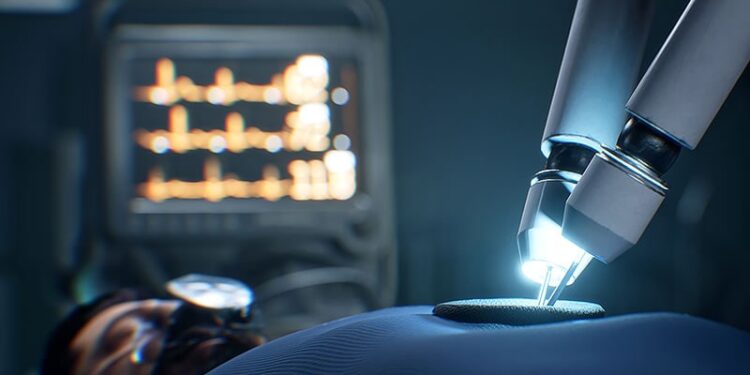The da Vinci robotic surgical system, developed by Intuitive Surgical, is the most widely used robot-assisted surgical platform worldwide. This enables surgeons to perform minimally invasive procedures with enhanced precision, flexibility, and control. For the first time, a systematic review and two real-world studies confirmed the safety and effectiveness of the system. These findings establish a new benchmark for the future of robotic surgery worldwide.
Over the past two decades, robotic surgery has significantly reshaped surgical care, offering improved precision and less invasiveness than traditional approaches. The da Vinci system currently dominates the global market, with more than 2.6 million procedures performed in 2024. In Italy, da Vinci platforms have been in use for over 25 years and are now installed in more than 200 hospitals, where they have been used to treat hundreds of thousands of patients each year. Despite this widespread adoption, comprehensive safety analyses, particularly regarding the frequency and clinical impact of technical malfunctions, are lacking. This is a key gap, particularly as new robotic platforms are emerging and must be evaluated against current standards.
Surgery Comparison
The COMPARE study, published in the Annals of Surgery, is the largest comparative analysis to date of robotic, laparoscopic, and open oncologic surgeries. This study reviewed data on 3.9 million procedures from 230 publications across 22 countries. It included 34 randomised controlled trials, 74 prospective studies, and 122 database studies. The procedures examined included seven complex cancer surgeries performed using the da Vinci robotic surgical system between 2010 and 2022: lung lobectomy, total or radical hysterectomy, radical prostatectomy, partial nephrectomy, right colectomy, low anterior resection, and total mesorectal excision and/or intersphincteric resection for rectal cancers.
A total of 1,194,559 robotic procedures using the da Vinci system were compared with 1,095,936 laparoscopic and video-assisted thoracoscopic procedures and 1,625,320 open surgeries. The primary outcomes included conversion to open surgery, operative time, estimated blood loss, transfusion rate, length of hospital stay, 30-day postoperative complications, readmissions, reoperations, and mortality rates.
Robotic surgery took longer than laparoscopy (mean difference [MD], 17.73 minutes) and open surgery (MD, 40.92 minutes), but this was offset by the key clinical benefits. Hospital stays were shorter than those with laparoscopy (MD, -0.51 days) and open surgery (MD, -1.85 days), and blood loss was significantly lower than that with open surgery (MD, -293.44 mL). Robotic surgery reduced the risk for conversion to open surgery by 56% compared with laparoscopy. The transfusion risk was 21% lower than that of laparoscopy and 75% lower than that of open surgeries. Thirty-day complication rates were 10% and 44% lower than those of laparoscopy and open surgery, respectively. Mortality was reduced by 14% and 46% compared with laparoscopy and open surgery, respectively. Overall, robotic surgery showed improved safety for patients.
Few Malfunctions
Complications related to technical malfunctions are rare; however, how rare are they? A systematic review published in the World Journal of Urology, led by Nicolò Maria Buffi, MD, and Andrea Piccolini, MD, from the Department of Urology at the IRCCS Humanitas Research Hospital and Humanitas University in Milan, Italy, addressed this question. The review included 25 studies published over the past 20 years, covering 3,308,134 robotic procedures and 12,986 malfunctions of the da Vinci surgical system.
Malfunction was defined as any unintended failure involving the robotic console, patient cart, instruments, or accessories that disrupted the workflow, required troubleshooting, caused delays, led to conversion, or resulted in patient injury. Malfunctions were classified as device-related (console or cart) or instrument-related (tools).
A related study in European Urology, led by Marco Paciotti, MD, from the Department of Biomedical Sciences, Humanitas University, and the Department of Urology, IRCCS Humanitas Research Hospital, analysed Intuitive Surgical data from 1,835,192 da Vinci X and Xi procedures performed globally in 2022, focusing on system‑generated customer messages, which are alerts generated by the da Vinci system in response to technological problems or incorrect platform use.
The meta-analysis reported a malfunction rate of 1%, with device malfunctions in 0.11%, instrument issues in 0.37%, and conversion due to malfunction in 0.09%. Among all the malfunctions, 12.9% led to conversion to open surgery and 7.7% to laparoscopy. Injuries linked to malfunctions were estimated at 0.01%-0.02%, typically minor and mostly due to electrical arcing (193 of 308 cases), causing limited tissue damage or burns.
System Reliability
Manufacturer data showed that 1,790,244 of the 1,835,192 planned procedures (97.55%) were completed without alerts. Alerts occurred in 44,948 procedures (2.45%), totalling 140,986 events. Of these, 81.18% (114,447 events) resolved without rebooting. Technical support was obtained for 14,231 procedures. Only 1202 procedures (0.07%) were interrupted due to alerts, and 945 cases (0.05%) required conversion. The specific causes of alerts and clinical outcomes were not analysed; therefore, a direct link between alerts and outcomes could not be determined.
Setting Standards
Buffi emphasised the need for clear benchmarks on the da Vinci system’s reliability and malfunctions. “Over the last 5-6 years, there has been a significant introduction of new robotic systems. Given that the da Vinci system (with which I specify that I have no conflict of interest) has a long history and is considered extremely reliable, I thought it was appropriate to establish benchmarks for the reliability of robotic surgery. This is important because we risk focusing on economics, that is, on the cost of one robotic system compared to another, without considering the advantages and reliability of the machine,” he said to Univadis Italy, a Medscape Network platform.
Buffi also highlighted a major gap in the field: “Currently, there is no true standard for assessing the reliability of robotic systems; only the CE approval process is required.”
According to Buffi, the da Vinci platform, particularly the latest models, has proven to be extremely safe. He explained that most issues in robotic surgery are linked to human error rather than flaws in technology. This underscores the crucial need for thorough training and education of healthcare professionals.
The key challenge is to effectively evaluate new platforms against current standards and ensure robust quality criteria for new entrants in the market.
This story was translated from Univadis Italy.
Source link : https://www.medscape.com/viewarticle/da-vinci-malfunctions-how-safe-robotic-surgery-2025a1000jym?src=rss
Author :
Publish date : 2025-07-29 06:10:00
Copyright for syndicated content belongs to the linked Source.











